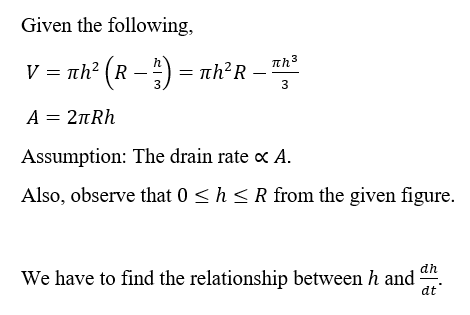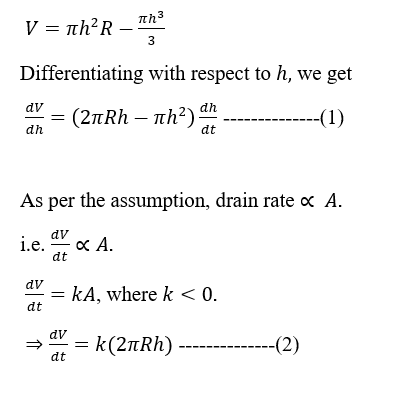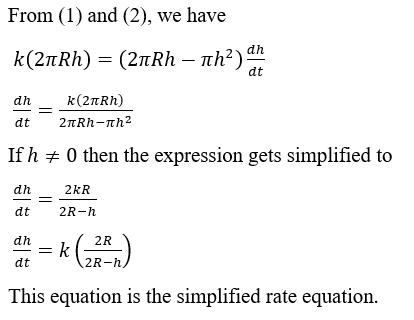
Advanced Engineering Mathematics
10th Edition
ISBN: 9780470458365
Author: Erwin Kreyszig
Publisher: Wiley, John & Sons, Incorporated
expand_more
expand_more
format_list_bulleted
Concept explainers
Topic Video
Question
First image is the word problem context. Please answer PART C from second image. Please show all steps and explain with clear handwriting. No cursive if possible.
![dh
and simplify it. Use this equation to explain why the drain rate h' (t) cannot be a
dt
(c) Solve the related rate equation from (b) for
constant function unless the filter is completely clogged (that is, unless k = 0.) [Hint: You may use h" (t) to be able to answer this. There
h (t)] and about
are other ways, too.] Suppose the water is completely drained at a time t = to . Talk about the limits lim,,
lim,¬to
[h' (t)]. To answer these, make an assumption that h (t) is a monotonically decreasing continuous function (i.e. water doesn't
climb back up!), and that h (to) = 0. Verify your findings analytically by using the related rate equation.](https://content.bartleby.com/qna-images/question/28092663-10ce-474b-a101-95a46deb92bf/0d399e07-7243-4a66-ba14-15a16eec96ac/4d2li7m_thumbnail.png)
Transcribed Image Text:dh
and simplify it. Use this equation to explain why the drain rate h' (t) cannot be a
dt
(c) Solve the related rate equation from (b) for
constant function unless the filter is completely clogged (that is, unless k = 0.) [Hint: You may use h" (t) to be able to answer this. There
h (t)] and about
are other ways, too.] Suppose the water is completely drained at a time t = to . Talk about the limits lim,,
lim,¬to
[h' (t)]. To answer these, make an assumption that h (t) is a monotonically decreasing continuous function (i.e. water doesn't
climb back up!), and that h (to) = 0. Verify your findings analytically by using the related rate equation.

Expert Solution
arrow_forward
Step 1

arrow_forward
Step 2
(c)


Step by stepSolved in 3 steps with 4 images

Knowledge Booster
Learn more about
Need a deep-dive on the concept behind this application? Look no further. Learn more about this topic, advanced-math and related others by exploring similar questions and additional content below.Similar questions
- Write a word problem that corresponds to each of the following models for subtraction. Comparison Missing addendarrow_forwardFirst image is the word problem context. Please answer PART F from second image. Please show all steps and explain with clear handwriting. No cursive if possible.arrow_forwardneed help with question C and D please helparrow_forward
arrow_back_ios
arrow_forward_ios
Recommended textbooks for you
 Advanced Engineering MathematicsAdvanced MathISBN:9780470458365Author:Erwin KreyszigPublisher:Wiley, John & Sons, Incorporated
Advanced Engineering MathematicsAdvanced MathISBN:9780470458365Author:Erwin KreyszigPublisher:Wiley, John & Sons, Incorporated Numerical Methods for EngineersAdvanced MathISBN:9780073397924Author:Steven C. Chapra Dr., Raymond P. CanalePublisher:McGraw-Hill Education
Numerical Methods for EngineersAdvanced MathISBN:9780073397924Author:Steven C. Chapra Dr., Raymond P. CanalePublisher:McGraw-Hill Education Introductory Mathematics for Engineering Applicat...Advanced MathISBN:9781118141809Author:Nathan KlingbeilPublisher:WILEY
Introductory Mathematics for Engineering Applicat...Advanced MathISBN:9781118141809Author:Nathan KlingbeilPublisher:WILEY Mathematics For Machine TechnologyAdvanced MathISBN:9781337798310Author:Peterson, John.Publisher:Cengage Learning,
Mathematics For Machine TechnologyAdvanced MathISBN:9781337798310Author:Peterson, John.Publisher:Cengage Learning,


Advanced Engineering Mathematics
Advanced Math
ISBN:9780470458365
Author:Erwin Kreyszig
Publisher:Wiley, John & Sons, Incorporated

Numerical Methods for Engineers
Advanced Math
ISBN:9780073397924
Author:Steven C. Chapra Dr., Raymond P. Canale
Publisher:McGraw-Hill Education

Introductory Mathematics for Engineering Applicat...
Advanced Math
ISBN:9781118141809
Author:Nathan Klingbeil
Publisher:WILEY

Mathematics For Machine Technology
Advanced Math
ISBN:9781337798310
Author:Peterson, John.
Publisher:Cengage Learning,

